Calling pastel de nata a Portuguese custard tart is a bit like calling a pasty a Cornish calzone – similar in principle, but a very different beast in reality. Instead of a short, crumbly pastry, the pastel de nata has a crisp, slightly salty, layered crust; and, rather than the firm, egg-rich fillings of the classic British or French custard tart, the filling is almost molten, and spiced with cinnamon and lemon zest, as opposed to our peppery nutmeg or sweet vanilla.
As chef Nuno Mendes explains in his love letter to the city of his birth, Lisboeta, they were originally sold at the Mosteiro dos Jerónimos in Belém. When the monastery was briefly closed in the early 19th century, the recipe found its way into the hands of an enterprising local businessman, and his shop now sells about 20,000 a day. I won’t claim that my recipe below is as good as a visit there, but I like to think these tarts are a pretty delicious homage.
The pastry

Some bad news here, I’m afraid. I try Mendes’ recipe using ready-made puff pastry, and it just doesn’t give the same crunchy effect as the real deal, which sits somewhere between puff and filo. If you really must have pastéis de nata and can’t be bothered with the effort of making your own pastry, make sure you get the all-butter sort of puff and roll it as thinly as possible before shaping as below, or layer up sheets of filo spread with soft butter instead.
The pastries I make myself all have the same basic ingredients: plain flour, salt, butter and just enough water to bind everything together. (Lard or vegetable fat, with their lower moisture content, may give a crisper result, but they don’t taste as good, and I don’t find any recipes suggesting them, though Mendes does tip me off that “a bit of pork fat in the moulds is nice”.) Where they differ is largely in how much butter they use and how they get it into the pastry.
Unlike shortcrust, this is a laminated pastry in which the fat acts as a sandwich filling between sheets of dough, separating them into the shatteringly crisp layers that are the hallmark of a proper pastel de nata. Having mixed flour and water, kneaded it until it comes together into a smooth dough (though a certain amount of gluten is required to hold the leaves together, overworking the dough will make it tough) and left this base pastry to rest, it’s time to introduce the butter. As pastry chef Nicola Lamb observes in her incredibly detailed exploration of the subject on her Substack, Kitchen Projects (which should be required reading for nata nerds), “There are two camps when it comes to getting your butter into the dough. On one side you’ve got camp ‘spread’, a traditional method which involves smearing soft butter on to the dough and then performing the folds. The second is camp ‘lock in’, which involves using firmer butter and a traditional method similar to how you’d approach a croissant or making puff pastry.”
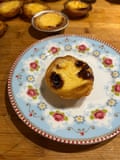
Based on her forensic research, Lamb suspects the pastéis de Belem use margarine, and their soft consistency suggests the spreading technique, but though I try this in both Rebecca Seal and Mandy Lee’s recipes, I find it hard to keep the soft butter in the pastry, and it has a tendency to leak out in the oven. The more familiar method, deployed by Lamb and Edite Vieira, involves rolling a cold rectangle of butter into the dough, which to me seems easier, though, as with the rolling issue, it’s worth reading through the various options and deciding which one suits you and, crucially, the space you have available. (Lee, who writes the brilliant Lady and Pups blog, cleverly uses a pasta machine, rather than a pin, to roll the pastry into thin sheets, which I think would work well for those not blessed with the world’s smallest kitchen, but I find it hard to house such long strips of dough.)
Vieira cuts the butter into small pieces, and dots it across the dough in three stages, while Lamb beats it into a rectangle and folds the pastry across it. Lamb’s pastry turns out to be the crispest, so I obediently follow her advice, though I’ve increased the butter content slightly, because I’ve opted for a less rich custard. (I find that the 1:1 ratio of butter to flour recommended in Vieira’s classic collection The Taste of Portugal, though delicious, means that her pastry softens very quickly and lacks the filo-like crunch of those recipes, such as Seal’s in her book Lisbon, which use less. This is my best compromise between flavour and texture.)
The filling
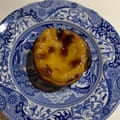
Steel yourself for another big decision. One of the reasons that pastéis de nata aren’t exactly custard tarts as we know them in the UK is that the custard itself is somewhere between an egg custard and Bird’s, in that it’s thickened by egg yolks and larger than normal amounts of starch. This combination is responsible for its unusual consistency: solid, yet oozy, and surprisingly light. Mendes clarifies that the filling “should be really runny – just perfect for small boys with coffee spoons”.
Neither Seal nor Vieira uses any starch for a richer, more solid result, while Lee, who was raised on the Macau egg tart (“more supple, with a flan-like texture that wiggles”), provides a hybrid best of both worlds with a minimally sweetened filling that’s solid enough to slice. On the other end of the spectrum, Mendes’ custard, which contains just two yolks compared with Seal’s 12 (though she makes a larger amount, this still represents a five-fold increase for the same amount of liquid), and almost as much sugar, has a pleasingly fondant quality. He, like Lamb, thickens it with plain and cornflour (Lee adds cornflour alone, for a smoother, but more jellied consistency).
Lee adds condensed milk and double cream to her filling, while Vieira uses single cream instead of milk. The problem with cream, I find with Vieira’s recipe, is that it has a tendency to split at high temperatures, giving a texture more reminiscent of a curd tart than a smooth custard (probably because my very hot oven is hotter than hers). I don’t find that problem with Lee’s custard, but the results, while delicious, are more dairy-rich than I’m aiming for.
Thanks to Lamb’s exhaustive investigations, for which I owe a great debt of gratitude, I know the sugar ought to be added in syrup form, because this helps stabilise the custard – and that the more you add, the oozier the finished result. To some extent, this can be balanced by salt in the pastry, but, though Mendes’ recipe comes the closest to the pastéis de nata I’ve enjoyed from Portuguese bakeries (my rather ambitious goal), I’ve reduced the sugar content slightly and added an extra half yolk, along with his butter, to give them a slightly richer colour and consistency.
The flavourings
Lemon peel and cinnamon are the classic flavourings: like Mendes, I’m going to infuse the milk and the syrup for a double whammy, which similarly helps counteract the sugar. You could also add vanilla, as Lee and Seal do, but I’m going to keep mine simple.
The filling and baking

If you’re serious about making nata, I’d recommend investing in some of the proper moulds – the ones I used are 7cm x 7cm x 5cm, though I couldn’t find the black ones Mendes recommends for maximum heat reflection. Because it’s a challenge to get the pastry to cook through before the tops burn, it’s important to ensure that whatever you use is as thin as possible. I also had very good results with Seal’s jam tart tins, which should be much easier to find, though they’re slightly more fiddly to fill.
For the same reason, you need to ensure your pastry is also stretched thin across the tin; I’d encourage you to watch a few videos online to get the idea, because it’s a difficult process to explain. Try not to squash the tops, however – as Seal explains, “if you can leave them a little thicker, they will frill out during cooking”.
Nata should be baked in a very hot oven – the Portuguese-American food writer David Leite was told that the pastéis de Belem takes them up to 400C, which is unlikely to be achievable in a home setting, if it is, in fact, even desirable. I find, when baking those that call for the oven to be heated to the max, which in my case is 300C, that the top layer of pastry burns before the base is fully cooked, so I’d recommend 260C instead, or as high as your oven will go if less.
For the same reason, I don’t think you need to turn your oven on for at least an hour beforehand, not least because of the costs involved, but you must heat a thick baking sheet along with it. The pastry should audibly sizzle when you put the tins on it, which will give the bases the best chances of cooking through to a crisp result.
You can pop the tarts under the grill at the end, as Lee suggests, if you’d like a bit more colour, or indeed use a blowtorch. But bear in mind that the longer you cook the custard, the higher it will rise, and then sink, so there is a tradeoff for those beautiful authentic black spots.
The finish

Vieira writes that pastéis de nata were traditionally served dusted with icing sugar and cinnamon, but nowadays most people prefer them without. I certainly think they’re sweet enough already, but I do like Mendes’ idea of brushing the tops with a little leftover syrup to render their burnished skins beautifully glossy. (This is purely cosmetic, however, so feel free to skip this step, if you prefer.)
These tarts are best enjoyed warm, rather than hot, and eaten on the day they’re made, though they do keep for a day or so (and will benefit from a quick crisp-up in the oven before serving). Both the pastry and the custard can be made the day ahead, if necessary – indeed, the pastry can be frozen for future nata-related emergencies.
Perfect pastel de nata
Prep 1 hr, plus resting and infusing
Bake 10 min
Makes About 24
For the pastry
230g plain flour
¼-½ tsp fine salt, depending on taste
120g cold water
150g cold unsalted butter
For the custard
210g white sugar
1 cinnamon stick, or 2 if short
Peel of 1 unwaxed lemon, in strips
500ml whole milk
20g unsalted butter, cubed
35g plain flour
2 tsp cornflour
5 egg yolks
You will need jam tart/fairy cake tins or, better still, pastel de nata tins, plus oil to grease them.
Start with the syrup for the custard. Put the sugar in a small pan with 150ml water, half the cinnamon stick and half the lemon strips. Bring to a boil and cook until slightly thickened – it’s ready when it hits about 107C.

If you don’t have a thermometer, run a teaspoon under cold water, then put a little syrup on to it and, when it’s cool enough, pinch it between two fingers: it should form a thin thread when you draw them apart. Take off the heat and leave to infuse (this can be done the day before).
Put the flour and salt in a bowl and stir briefly. Add the water, and stir with one hand until it just comes together into a dry dough.
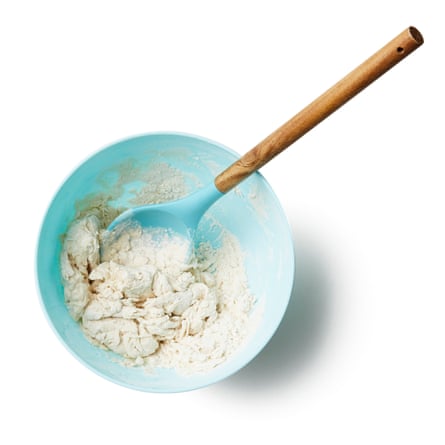
Turn out on to a clean surface and knead until smooth. If the dough is stubbornly flaky, wet your hands to do this, but try not to add more water unless it’s absolutely necessary. Wrap and chill for 20 minutes.
Meanwhile, cut the butter into small, flat tiles. Cut out two rectangles of greaseproof paper, and draw a 15cm x 20cm rectangle in the middle of one of them.

Arrange the tiles of butter in a tight rectangle in the centre of the other piece of paper, then put the other sheet on top drawing side up and roll out the butter between the two sheets until it roughly fills the drawn rectangle.

Put the butter and its paper in the fridge.
Roll out the dough on a lightly floured surface to about the same size as the butter rectangle, then, keeping this central rectangle thicker, roll or stretch out the sides so you end up with a cross shape, with four thin arms and a thick, butter-sized rectangle in the centre.
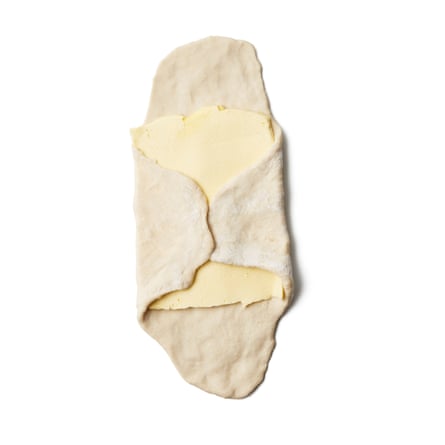
Peel the paper off the butter, then lay it in the centre of the cross and fold the arms over the top, so they completely enclose the butter.
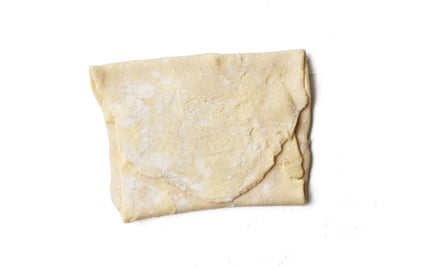
Roll out the dough rectangle to about three times its original length, then fold the top third down into the middle and the bottom third up over the top. Turn the dough 90 degrees, then repeat the roll and fold process. Wrap and chill for 20 minutes, then roll out for a final time to a ½cm-thick rectangle that’s about 20cm x 35cm.
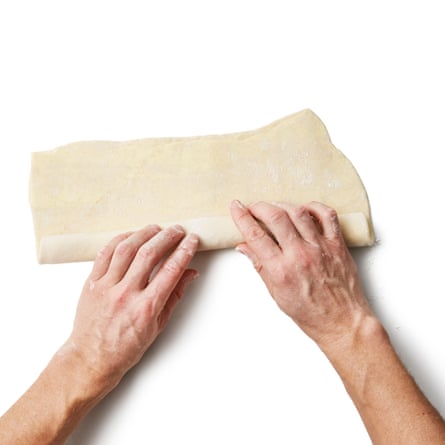
With the long side facing you, roll up very tightly into a long sausage and wrap well (you may find it easier to cut it in two before wrapping). Chill for at least an hour.
Put the milk in a medium pan with 10g of the butter, the other half of the cinnamon stick and the remaining strips of lemon peel.
Bring to just below a boil, then take off the heat and leave to infuse for at least 30 minutes. Meanwhile, put the flours in a heatproof jug.
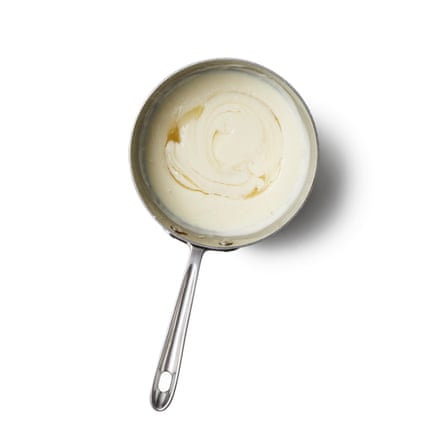
Remove the flavourings from the infused milk, then pour a little of it into the flour jug, whisking to dissolve the flours, until you have a smooth paste, then whisk in a little more, repeating until about half of the milk is in there. Return this to the pan, set it over a low heat and stir until the milk mix has thickened to the consistency of double cream. Take off the heat, stir in the remaining butter and almost all of the syrup, having first removed the flavourings, but keeping a couple of spoonfuls of syrup back for later. (You can make the custard up to this point the day before, if convenient.)
When you are ready to bake, get the pastry out of the fridge to warm up slightly. Heat the oven to 260C conventional/gas 9 (the fan is not helpful here), or as high as your oven will go if less, and put two metal trays inside to heat up. Lightly grease your nata tins or shallow fairy cake/jam tart tins.
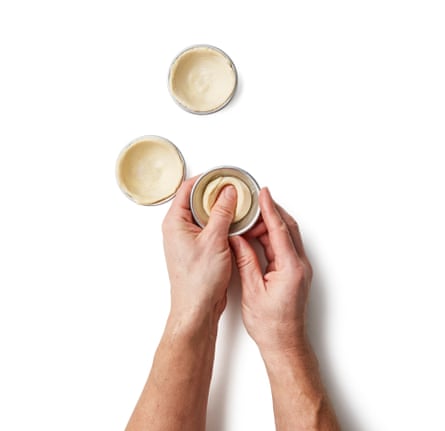
Cut the pastry into roughly 17g slices, put each one in a tin or mould and use damp fingers to press it all the way up the sides and slightly proud of the top. Be careful not to squash the thicker top edge, because this will form the rim. Return to the fridge for 20 minutes.

Beat the egg yolks into the custard and fill the cases by three-quarters with custard.

Working quickly, put the tins on the hot sheets and bake for about 10 minutes, until the pastry is dark golden and the custard starting to brown in spots – you’ll need to judge by eye when they’re ready, because this very much depends on your oven.
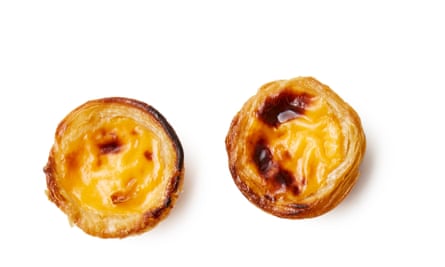
Brush lightly with the reserved syrup, if using, while still warm.
Pastel de nata: are they worth making at home, or are they something best left to the professionals? If the former, what are your top tips? And if the latter, where serves up the best example?
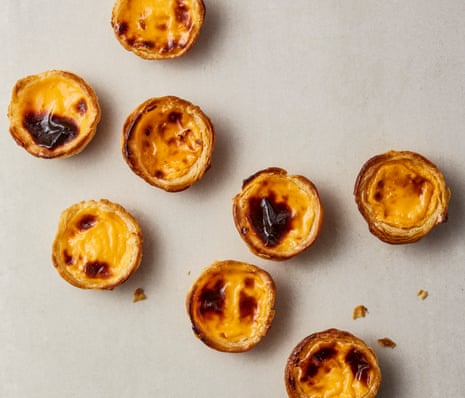
Comments (…)
Sign in or create your Guardian account to join the discussion